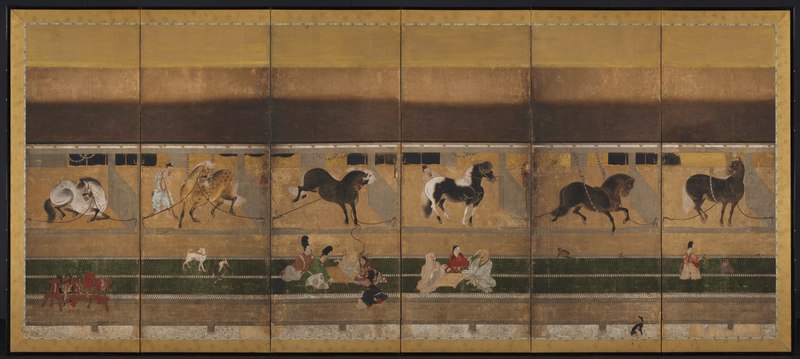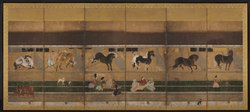File:Tosa School - Horses and Grooms in the Stable - 1934.373.1 - Cleveland Museum of Art.tif

Original file (16,961 × 7,616 pixels, file size: 369.59 MB, MIME type: image/tiff)
Captions
Captions
Summary[edit]
| Warning | The original file is very high-resolution. It might not load properly or could cause your browser to freeze when opened at full size. |
|---|
| anonymous: Horses and Grooms in the Stable
|
||||||||||||||||||||||||
|---|---|---|---|---|---|---|---|---|---|---|---|---|---|---|---|---|---|---|---|---|---|---|---|---|
| Artist |
Tosa School |
|||||||||||||||||||||||
| Title |
Horses and Grooms in the Stable |
|||||||||||||||||||||||
| Part of |
Horse Stable |
|||||||||||||||||||||||
| Object type |
painting |
|||||||||||||||||||||||
| Description |
The size of this intriguing pair of byøbu is noteworthy because its original dimensions were different. The horizontal band of golden paper at the top was probably added between the seventeenth and nineteenth centuries. What is more, comparing these screens with others de-picting stable scenes suggests that the bottom may have been trimmed, seemingly bringing the viewer closer to the setting and its activities. The impressive steeds are tethered in separate stalls beneath a cedar bark roof much like those still used in traditional Shinto shrines. Each horse is rendered as a particular animal through placement, pose, and colora-tion. In front of the divider posts for the stalls, which coincide with the individual panel borders, is a fascinat-ing mélange of medieval people and animals. Arranged on and along the double band of deep green tatami mats or the brown wood veranda upon which the tatami are placed, these vignettes provide insights into the culture and society of the later Muromachi period. The horses exhibit the isolated, graceful stateliness long associated in Japan with their power and beauty, and the human figures are comfortable with one another despite their considerable age and social differences. We see stable grooms, courtiers, aged priests, a page boy, a falconer, and a young child playing with a monkey. Also conspicuous are the riding and gaming equipment, animals and birds, and especially the various styles of textiles then in vogue. Not portraits, the figures instead represent types, but they do recall the enduring Japanese interest in mirror-ing real people from varying social levels. This genius for expressing human wit as well as the overall abstract design sense emanates from a deep familiarity with everyday reality. Following the earlier illuminated handscroll tradi-tions of the Heian and Kamakura periods in which views of everyday life occupy common ground with religious and aristocratic subject matter, the stable theme repre-sents the revival of attention to patently indigenous subject matter, executed with a palette of mineral pig-ments in yamato-e, the colorful native Japanese style. Such paintings stand in stark contrast to imported subject matter executed with ink washes in kara-e, or Chinese style. The Four Accomplishments [5] provides a timely example of that genre, instructive in contrasting palettes, techniques, settings, and depictions of figures. Of the byøbu known with this subject, it is cur-rently regarded as the earliest that survives. Its author remains a mystery, as is normally the case among yamato-e artists before 1600. Nevertheless, it has a distinguished history of ownership dating back to the sixteenth-century Tokugawa family, whose paulownia crest appears in gold lacquer on a saddle in the left screen. |
|||||||||||||||||||||||
| Date |
1500 date QS:P571,+1500-00-00T00:00:00Z/9 |
|||||||||||||||||||||||
| Medium | Six-panel folding screen; ink, color, and gold on paper | |||||||||||||||||||||||
| Dimensions | Image: 146.1 x 346.6 cm (57 1/2 x 136 7/16 in.); Overall: 163.3 x 363 cm (64 5/16 x 142 15/16 in.); Closed: 163.8 x 62.3 x 11.5 cm (64 1/2 x 24 1/2 x 4 1/2 in.); Panel: 160.3 x 60.5 cm (63 1/8 x 23 13/16 in.); with frame: 163.3 x 366 cm (64 5/16 x 144 1/8 in.) | |||||||||||||||||||||||
| Collection |
institution QS:P195,Q657415 |
|||||||||||||||||||||||
| Current location |
Japanese Art |
|||||||||||||||||||||||
| Accession number |
1934.373.1 |
|||||||||||||||||||||||
| Place of creation | Japan, Muromachi period (1392-1573) | |||||||||||||||||||||||
| Credit line | Edward L. Whittemore Fund | |||||||||||||||||||||||
| References |
https://clevelandart.org/art/1934.373.1 |
|||||||||||||||||||||||
| Source/Photographer | https://clevelandart.org/art/1934.373.1 | |||||||||||||||||||||||
Licensing[edit]
| This file is made available under the Creative Commons CC0 1.0 Universal Public Domain Dedication. | |
| The person who associated a work with this deed has dedicated the work to the public domain by waiving all of their rights to the work worldwide under copyright law, including all related and neighboring rights, to the extent allowed by law. You can copy, modify, distribute and perform the work, even for commercial purposes, all without asking permission.
http://creativecommons.org/publicdomain/zero/1.0/deed.enCC0Creative Commons Zero, Public Domain Dedicationfalsefalse |

|
This file was donated to Wikimedia Commons as part of a project with the Cleveland Museum of Art. See the Open Access at the Cleveland Museum of Art.
|
File history
Click on a date/time to view the file as it appeared at that time.
| Date/Time | Thumbnail | Dimensions | User | Comment | |
|---|---|---|---|---|---|
| current | 15:47, 1 February 2019 |  | 16,961 × 7,616 (369.59 MB) | Madreiling (talk | contribs) | pattypan 18.02 |
You cannot overwrite this file.
File usage on Commons
The following page uses this file:
File usage on other wikis
The following other wikis use this file:
- Usage on en.wikipedia.org
- Usage on www.wikidata.org
Metadata
This file contains additional information such as Exif metadata which may have been added by the digital camera, scanner, or software program used to create or digitize it. If the file has been modified from its original state, some details such as the timestamp may not fully reflect those of the original file. The timestamp is only as accurate as the clock in the camera, and it may be completely wrong.
| Width | 16,961 px |
|---|---|
| Height | 7,616 px |
| Bits per component |
|
| Compression scheme | Uncompressed |
| Pixel composition | RGB |
| Image data location | 17,958 |
| Orientation | Normal |
| Number of components | 3 |
| Number of rows per strip | 7,616 |
| Bytes per compressed strip | 387,524,928 |
| Horizontal resolution | 300 dpi |
| Vertical resolution | 300 dpi |
| Data arrangement | chunky format |
| Software used | Adobe Photoshop CS6 (Windows) |
| File change date and time | 15:34, 8 July 2013 |
| Color space | sRGB |
| warning | identify: Incompatible type for "RichTIFFIPTC"; tag ignored. `TIFFFetchNormalTag' @ warning/tiff.c/TIFFWarnings/912. |
- Large images
- Artworks with known accession number
- Artworks with Wikidata item
- Artworks with Wikidata item missing genre
- Artworks with Wikidata item missing dimensions
- Artworks with Wikidata item missing medium
- Artworks digital representation of 2D work
- CC-Zero
- Images from Cleveland Museum of Art
- Uploaded with pattypan

